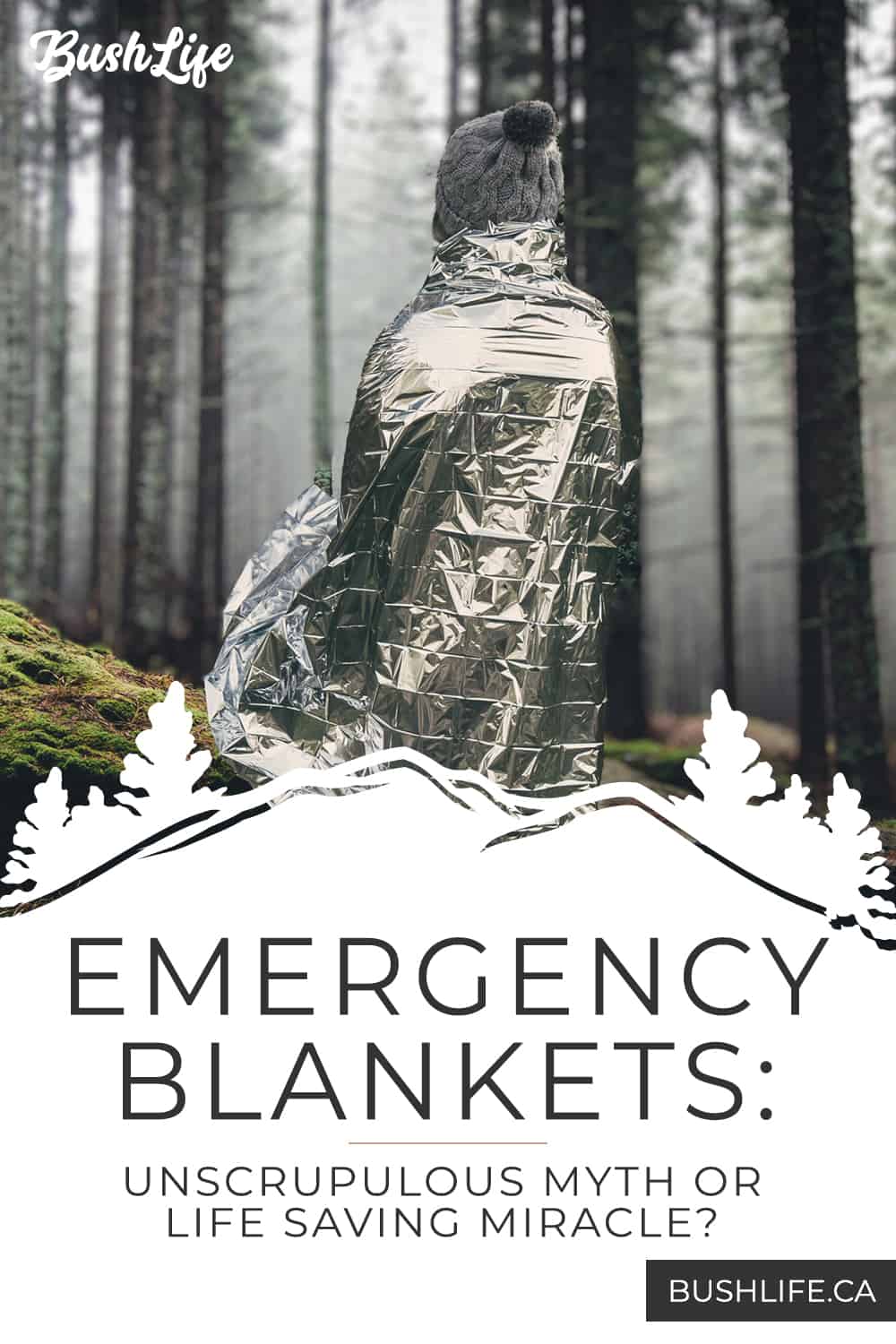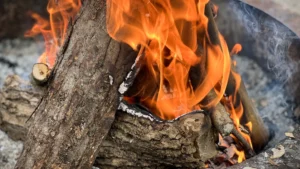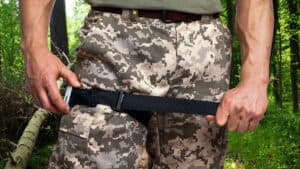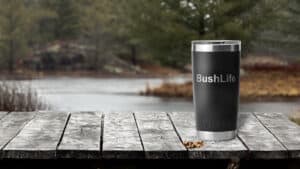We’ve talked about the emergency blanket in a few posts, and those who follow the blog know it’s a love-hate relationship with these things. The pros are simple: an ultralight, portable and versatile gear. That also means they have a place in our packs.
Discloure: Posts may contain affiliate links. Purchases made through our links result in a small commission to us at no charge to you. We only recommend products that meet our brand standards based on testing and first hand use by our authors.
The cons, however, are bad, very bad! Most people have a deeply misconstrued expectation of what an emergency blanket is for. Not to mention what its limited capabilities are. This is, of course, thanks to overhyped marketing from companies trying to pawn off their products to the masses rather than those who have a use for one. The unsuspecting purchaser believes this miraculous blanket will keep them alive when the SHTF. Sadly, the way most people in cold climates intend to use these will lead to near-certain death.
Emergency blankets are way over-hyped, and most people have a completely wrong notion of how, when and why to use them. We’re going to fix that today.
What is an Emergency Blanket?
An emergency blanket is usually very thin and made of plastic. One side is foil-lined or at least lined with some form of reflective material, the intent being to reflect body heat.
Generally, these blankets are small or typically suited for one person. The very properties that make for a small and lightweight piece of gear also mean that most emergency blankets are made cheaply and of flimsy construction. Great care should be taken in the quality department when buying one.
The emergency blanket, however, is not what most people think. To define it properly, we need to rename it! An emergency blanket is technically a casualty blanket and is a concept born in the military.
It is indeed standard issue gear for military members, even for soldiers on duty in the desert where you’ll find no shortage of heat. One may wonder why an emergency blanket is needed in the desert. The answer is quite simple and based purely on an emergency medical concept: with enough blood loss, it’s challenging to maintain core body temperature.
What is an IFAK?
The military definitely loves their acronyms, and IFAK is no different. IFAK stands for individual first aid kit. But you won’t find band-aids in here. Most items in an IFAK are to treat severe wounds and STOP the bleeding, for example, a tourniquet or Israeli pressure bandage. In most cases, the soldier can self-apply these trauma items, if, of course, they are conscious.
Further Reading: Time To Secure Survival with a CAT Tourniquet
After stopping the bleeding, the patient is wrapped in a casualty blanket to help maintain body heat while being transported or waiting for proper medical treatment from a medic.
And no, we haven’t sidestepped from emergency blankets by discussing the IFAK. THIS is exactly what the “emergency” or casualty blanket is designed to do. It is its true and ultimate purpose.
Further Reading: Emergency Medical Kit: Surprisingly Life and Death is 9 Items
What About My $10 Survival Blanket?
That heading is chosen carefully and for good reason. Other than “emergency,” these blankets are also mass-marketed as survival blankets. Moving forward, we can use these terms interchangeably as it’s all about the same thing.
Is There Any Value to an Emergency Blanket Outside of Medical Use?
Yes, of course, we’ll get to that soon. Firstly, we need to consider the intended civilian use – which is to stay warm! I’m sure millions of people have seen these $10 emergency blankets close to cash registers while waiting to be served. I’m also sure they think, ‘This emergency blanket would be great for the car.’ That means we need to focus on its merits solely as a blanket.
So, let’s consider this scenario: It’s -30 degrees Celcius, and the car breaks down in the middle of nowhere, and you need to spend the night. Do you want to open the glove box and get a piece of plastic, or would you rather have a real blanket? If anyone thinks that shiny plastic piece is magical enough to keep you warm, they are wrong. Dead wrong, and I’m afraid.
Emergency Blanket vs a Real Survival Blanket
Around October or November, a real survival blanket is in my trunk. It’s usually there until about March or April. We are talking about a military MMS sleep system. It’s a sleeping blanket that nests inside another sleeping blanket, which provides more temperature range options. Then it all goes into a bivy sac that can be tossed on the ground or into the snow. -30 is now achievable, even outdoors with no cover!!!
The problem is the MMS blanket weighs almost 10 lbs and is massive! It’s big, even when compressed into the stuff sack. For clarity, the size or footprint of the blanket isn’t big, as these are tight and uncomfortable mummy sacs. By big, we mean there is so much bulk from all the insulating fill inside the blanket.
Reading this, one may laugh thinking you’re not hiking with one of these, and you would be right. But you’re not hiking with a little emergency blanket and staying alive, either! Once you realize what it takes to stay warm, the limitations of the little plastic blanket become pretty obvious.
Proper Ways to Use an Emergency Blanket!
There is no doubt the emergency blanket does help hold in some body heat. It does this thanks to its foil that reflects heat in, granted and agreed.
Air is also an insulator, and these blankets certainly don’t breathe. That means trapped air around your body will add an insulating factor – don’t expect much in the R-value department. Trapped air can also be your enemy, which we’ll go over a little further below.
The point is that in very moderate temperatures, there are some merits to these blankets. We should be realistic that no one will survive any heavy cold with one of these emergency blankets. At least not without some additional gear!
Adding a Candle
So you are out in the woods, something goes wrong, and it’s getting very cold. All you have is this plastic blanket, and it’s not helping. Hopefully, you packed a candle!
There is quite a bit of heat that comes off of a candle. Trapping the air we covered above, the emergency blanket with a heat source has more value. To use an emergency blanket with a candle, find a spot to sit. Get a candle lit around your feet and wrap yourself with this blanket. Extreme caution is an absolute must, or being cold will be the least of your problems. This method works, and it works well! Good luck getting some sleep:)
Make a Fire
Hands down, the most widely used method of employing the emergency blanket (from those in the bush and those who KNOW what they are doing) is acting as a reflective tarp. Start by stringing a ridgeline and attaching the blanket to it. Then you stake out the bottom, trying to get the blanket angled at 45 degrees to the ground – the reflective side facing down!
Immediately, this serves two purposes. When you get under it, this becomes your cover from the elements above. If you place it right, you’ll also block the wind.
Next, you will want to make a fire beside you but not under the blanket for obvious reasons. The point of this is to reflect some of the heat from your fire. Having the reflective foil side comes in handy with this method.
Further Reading: 7 Fire Kit Survival Essentials That You Should Carry
Finally, you wake up all night to feed the fire. You’ll also periodically do push-ups, sit-ups or any other physical activity (without working up a sweat) to keep you warm. Sorry to be the bearer of bad news here, but while you might live, it may very well be the most miserable night you’ve ever had. These are the very survival instructions that seemingly went missing on the shiny packaging of these “survival blankets.”
Signalling Device
The second use for the shiny foil side of your emergency blanket has nothing to do with heat. A giant, bright, silver object is easier to spot in the woods amongst the trees than anything else. This applies where you are looking to be spotted from the ground or an aerial rescue operation.
Other Uses for Emergency Blankets
In a genuine survival situation, we have to do what’s called, ‘improvisation.’ You use whatever materials are at your disposal to achieve whatever survival needs you require.
Your emergency blanket is waterproof, thanks to the fact that it’s plastic, which allows you to collect water with it. Cut off a small piece, and you now have some significant tinder for a stubborn fire.
Should you have a tarp and blanket, great. Use the blanket as a ground sheet to stay dry. Whatever the case, there are infinite uses for even the most mundane objects. And in the woods, a large plastic sheet isn’t mundane at all.
Water Can Be Your Worst Enemy
I grew up in the 80’s and remember fishing on those rainy days. Perhaps you remember those hideous yellow ducky rain suits we used to have. Again, some form of unbreathable plastic. While waterproof, after some time of wearing this ducky suit, you are soaked from head to toe! We used to say it finally soaked through as we didn’t know any better, but the truth is, we were soaked in our sweat!
Our bodies always release moisture, and you need not be “sweating” from heat to achieve that. Sweating accelerates the process. Modern fabrics meant for rain are water permeable in one direction, which is away from your body. There’s an art to locking out water on the shell while still being breathable from the inside. Fabrics like these are expensive, such as Gore-tex. However, this is not the technology you’ll find in a $10 emergency blanket.
When the average person turns to an emergency blanket, it’s almost always for warmth. That means we are in a cold climate scenario and already know that the cold can be deadly. Being cold and wet is infinitely more deadly!!!
Beware of Moisture
If wrapping yourself too tight in an emergency blanket, theoretically, the risk of trapping moisture is there. While the risk level is probably low, you can mitigate this by occasionally opening up when you feel yourself getting wet. The same holds true anytime you use something that doesn’t breathe tightly around your body.
Emergency Blanket, The Verdict
I carry one of these with me in my pack. The pros far outweigh the cons when you know how to use an emergency blanket. But I also generally carry a tarp or military poncho, which doubles as a tarp simply by tying off the hood.
When it’s cold and physically feasible, I pack a real blanket – which may not make it into the woods but will at least be close by at camp or in the vehicle. Let’s not forget fire-making tools, which are ALWAYS in my backpack!

Pictured above are some of my blankets. As an extra or backup piece of gear, they should be small enough to tuck somewhere in a pack without stealing space from something else.
However, there is ZERO value to carrying the super thin ones, such as the one on top. If it was back in its packaging, it would be a third of the size of the one in the middle. When they fold up that small, they have no meat or thickness and are likely to fall apart before providing any real value. More specifically, the blanket on top is equivalent to tinsel on a Christmas tree.
Amongst the mass-marketed blankets, the SOL Emergency Blanket in the middle is a little heavier and better built. But even so, there is only so much you can expect in the sub $10 range, and I can’t see tarping as an option here.
The Arcturus Heavy Duty Survival Blanket

The Arcturus Heavy Duty Survival Blanket is a phenomenal alternative to your plastic emergency blanket. It is what I strongly suggest for anyone who wants a serious emergency blanket that can be tarped. The Arcturus is a heavy gauge, fully re-foldable/useable, and it takes an absolute beating!!! Especially for anyone who doesn’t carry a tarp – it’s a one-stop solution!
The last thing you want is to be in a survival situation and have your blanket fall apart on you. Anyone who has spent time in the woods knows how rough things can be and how quickly you can shred your gear. Add wind, rain or snow to the mix, and it’s a recipe for disaster. The Arcturus emergency blanket is the real deal!
In conclusion, survival is about having the right gear at the right time and in the hands of people with the proper skills.
Please share this post and educate your loved ones – because there is a use for the emergency blanket, just not the way most people expect.
Bookmark this post on Pinterest for future reference!









